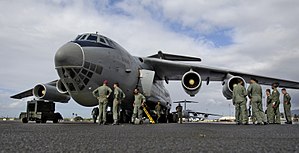Operation Cactus
| 1988 Maldives coup d'état | |||||||
|---|---|---|---|---|---|---|---|
| Part of Sri Lankan Civil War and Indian intervention in the Sri Lankan Civil War | |||||||
 An Indian Air Force Ilyushin Il-76 transport aircraft of the model used to transport Indian paratroopers to Male. |
|||||||
|
|||||||
| Belligerents | |||||||
|
|
|
||||||
| Commanders and leaders | |||||||
|
|
|
||||||
| Strength | |||||||
| 1,600 Indian paratroopers | 80–100 gunmen | ||||||
| Casualties and losses | |||||||
| 19 killed, mostly PLOTE mercenaries, but also two hostages killed by the mercenaries Several mercenaries captured |
|||||||
The 1988 Maldives coup d'état was the attempt by a group of Maldivians led by Abdullah Luthufi and assisted by armed mercenaries of a Tamil secessionist organisation from Sri Lanka, the People's Liberation Organisation of Tamil Eelam (PLOTE), to overthrow the government in the island republic of Maldives. The coup d'état failed due to the intervention of the Indian Army, whose military operations efforts were code-named Operation Cactus by the Indian Armed Forces.
Whereas the 1980 and 1983 coup d'état attempts against Maumoon Abdul Gayoom's presidency were not considered serious, the third coup d'état attempt in November 1988 alarmed the international community. About 80 armed PLOTE mercenaries landed in the capital Malé before dawn aboard speedboats from a freighter. Disguised as visitors, a similar number had already infiltrated Malé earlier. The mercenaries quickly gained control of the capital, including the major government buildings, airport, port and television and radio stations. However, they failed to capture President Gayoom, who fled from house to house and asked for military intervention from India, the United States, and the United Kingdom. Indian prime minister Rajiv Gandhi immediately dispatched 1,600 troops by air to restore order in Malé.
The operation started on the night of 3 November 1988, when Ilyushin Il-76 aircraft of the Indian Air Force airlifted the elements of the 50th Independent Parachute Brigade, commanded by Brig Farukh Bulsara, the 6th Battalion of the Parachute Regiment, and, the 17th Parachute Field Regiment from Agra Air Force Station and flew them non-stop over 2,000 kilometres (1,240 mi) to land them over the Malé International Airport on Hulhule Island. The Indian Army paratroopers arrived on Hulhule in nine hours after the appeal from President Gayoom.
...
Wikipedia
